-
Born 28 October 1955 in Seattle, Washington. His father was WHG III but he changed his name to WHG Jr. when he went into World War II (did not want to be teased about his "high-tone" name. His mother was Mary Maxwell Gates from a prominent Seattle family. They were married in 1951.
His trademark rocking back and forth started in his childhood. He was very smart and bored in school. His maternal grandmother Adelle Maxwell taught him a variety of card games and she was also fiercely competitive.
In 1968 at age 13 as an 8th grader while at Lakeside School (a private exclusive school for boys) he got access to a Teletype connected by a 110 baud modem to a GE MARK II time-sharing system that only had BASIC (Beginner's All-Purpose Symbolic Instruction Code). The teletype combined a keyboard, a printer, and a paper tape punch and reader. It cost $89 per month to rent the teletype and $8 an hour for on-line fees (about $450 and $40 in 1998 dollars, respectively). Gates quickly became an avid programmer and one of the main users of the system.
Also at Lakeside was Paul Allen who was in the 10th grade and also an avid programmer. That same year Gates & Allen get access to a PDP-10 run by a private company in Seattle. The company offered free time to the Lakeside school kids to see if they could crash the system. Gates proved to be particularly adept at doing so.
Paul Allen and Bill Gates, 1977
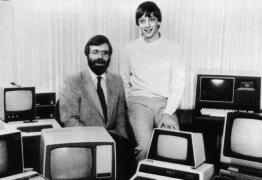
DEC PDP-10
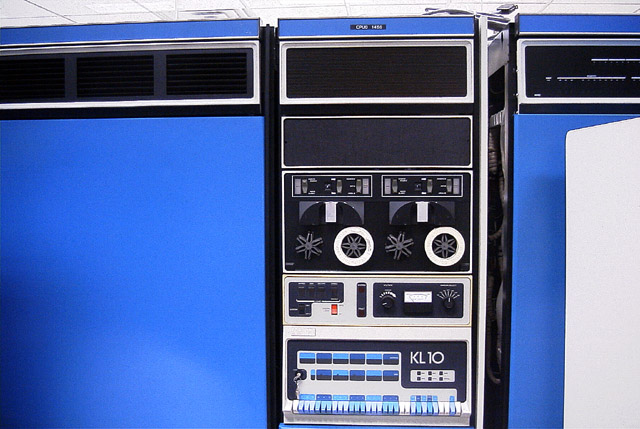
While Gates became a wizard at BASIC, Allen borrows the DEC manuals and learns the instruction set, the macro assembler, and the Monitor (program that controls the hardware and the input/output) of the PDP-10! When the free time ran out Gates and Allen figure how to get free time on the PDP-10 by logging in as the system operator.
It was about this time 1968-69 that Gates' develops his reputation in school for not suffering fools gladly. "That's the stupidest thing I've ever heard of!" became one of his catchphrases. One that he uses frequently to this day.
When the private company running the PDP-10 Gates & Allen were using goes bankrupt in March of 1969, Allen went over to the University of Washington and began using a Xerox computer by pretending he was a graduate student. Gates soon followed and they used the UofW computer until an intolerant professor caught them at it and they were barred.
Gates & Allen then went to another room in the building and began using a CDC Cyber 6400 designed by Seymour Cray. It ran nothing but batch using a card-reader.
Lakeside got two small DEC computers on loan later in 1969 and Gates obtained a paper tape with an assembler and the source code for BASIC for a PDP-8. He used it to begin work on a BASIC interpreter.
In the fall of 1970, Gates & Allen, and their friends Ric Weland and Kent Evans (killed in a hiking accident in 1972), get access to a PDP-10 in Portland, Oregon, and agree to write an accounting program in COBOL in exchange for free computing time. Gates & Allen finish the project on time in June 1972 (Allen was in college by then - WSU at Pullman).
In the spring of 1972 Gates agrees to help Lakeside develop scheduling software for its classes. The software was written in FORTRAN and was finished on time in June 1972 with the aid of Allen.
In the Fall of 1972 when Gates was a Senior at Lakeside and Allen was in college, they decide to build a computer using an INTEL 8008 chip. Their idea was to build a computer to count traffic. Gates had dubbed the company Traf-O-Data (it never made much money). Allen used the USW IBM System 360 computer to build a software simulator of the 8008! This would allow Gates & Allen to write software for the 8008 chip on the IBM computer!
Christmas 1972 Gates & Allen are hired by TRW to write software for a real time data analysis system for the Bonneville Power Administration. The software was to run on DEC PDP-10s. (Gates was able to treat his programming adventure as a "senior project.")
-
In the Fall of 1973 Gates enters Harvard where he was an indifferent student. He discovers Pong in 1974 and becomes obsessed with Atari's follow-on game Breakout (written by Steve Jobs and Steve Wozniak in 4 days).
Gates meets Steve Ballmer in the fall of 1974 at Harvard.
Steve Ballmer and Bill Gates
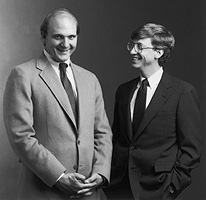
Allen moves to Boston to work at Honeywell in the fall of 1974.
That December, the January, 1975 issue of Popular Electronics hit the newsstands with its front cover picture of the Altair 8800 Computer. The computer kit was made by MITS (Micro Instrumentation and Telemetry Systems) which was located in Albuquerque, NM.
MITS Altair 8800 Computer
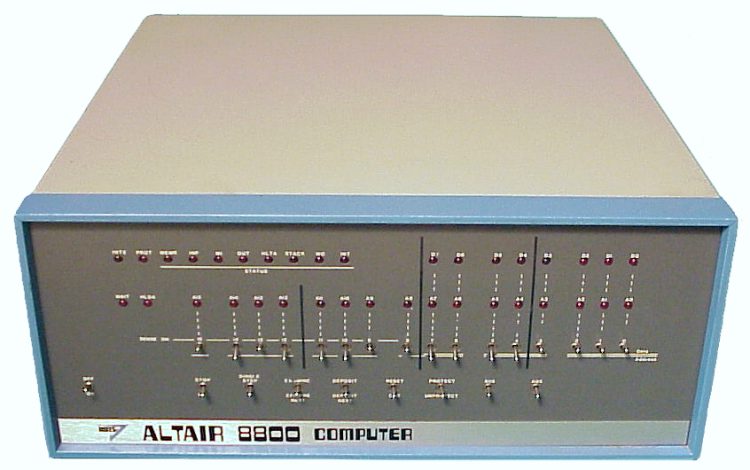
The Altair used the Intel 8080 chip and had 256 Bytes of RAM. Programs had to be entered by flipping toggle switches on the front of the computer. The computer did not come with a terminal so most people hooked up a teletype to it in order to use it (you also needed an I/O card and a card to plug the I/O card into).
Gates and Allen saw their opportunity. If they wrote BASIC for the 8080 MITS machine then they could make money selling it not only to Altair users but also to other 8080 based computers that were almost certainly going to emerge to compete with the Altair.
Their big advantage was that they had Allen's Intel 8008 simulator that they were confident could be quickly converted to an 8080 simulator and used to develop the BASIC Interpreter. After signing an agreement with their collaborator on the Traf-O-Data project freeing them to write software for unrelated projects, Gates and Allen write MITS on 2 January 1975 offering MITS a BASIC Interpreter for the Altair.
Allen immediately went to work on the 8080 simulator and Gates designed the BASIC and began writing the assembly language code. Monte Davidoff, a freshman at Harvard who they met accidentally, was hired to write the floating-point mathematical code.
By mid-February 1975 the BASIC was running on the 8080 simulator. They arranged to take the BASIC to New Mexico for a demonstration. It had never run on the Altair or any 8080 chip yet - just on the simulator running on Harvard's PDP-10!
The night before Allen was to fly down Gates stayed up all night checking the code before making the paper tape. The next morning Allen flew to Albuquerque and realized in mid-flight that he did not have a loader (the software to make the Altair talk to the teletype so the paper tape with the BASIC could be put into the computer). Allen wrote the loader in machine code on the flight down.
At MITS Allen entered the loader by flipping switches (binary code!) on the front panel, loaded the paper tape and the BASIC worked! (The future billionaire had to borrow $40 for his motel bill!) Gates and Allen had a deal and Allen was made "Vice President and Director of Software" at MITS.
On 22 July 1975 Gates (then 19 years old) and Allen sign a deal with MITS for $3000 plus a royalty for each copy of BASIC sold. MITS got the exclusive right to sublicense the software but agreed to use its "best efforts" to commercialize the program.
Also in July 1975 Gates & Allen form a partnership, Micro-Soft, with Gates 60% and Allen 40%. Gates argued for the larger share based upon the fact that Allen was a full time employee of MITS. Their initial investments were $910 and $606 respectively (60-40).
This first business venture of Gates & Allen typified how Microsoft operated for many years. In the words of Stephen Manes & Paul Andrews: "Announcing a product that didn't exist, developing it on the model of the best version available elsewhere, demonstrating an edition that didn't fully work, and finally releasing the product in rather buggy form after a lengthy delay."
In October 1975 MITS decides to bring out the Altair 680 which used the Motorola 6800 processor. Gates & Allen, in a pattern that was to repeat time and time again, see an opportunity to rework an existing product (BASIC) for a new market. Allen wrote a simulator for the 6800 and Ric Weiland (another of their friends from Lakeside) rewrote Gates's BASIC for it.
MITS Altair 680 Computer
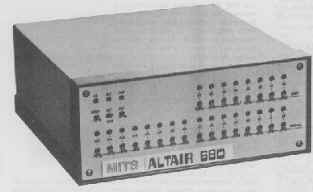
Micosoft income for 1975: $16,005.
Gates became increasingly upset with the widespread piracy of Microsoft's during the early 1975-76 period. His response was his famous "An Open Letter to Hobbyists" that was sent out to every major computer publication in February 1976. In it he decried the practice which he regarded as simple theft and his statement caused a huge uproar.
One of the many (mostly hostile) responses Gates received was a suggestion that BASIC simply be put into ROM (Read Only Memory). Computer code burned into silicon rather than being on a paper tape would be very hard to pirate. Gates and Allen eventually become convinced that ROM-based software was the way to go but in the meantime they decide to begin selling BASIC outright to manufacturers on a non-exclusive basis for a flat fee.
Because MITS only had rights to the 8080 version of BASIC, Gates and Allen licensed the 6800 BASIC to MITS for a flat fee of $31,200 to be paid at $1300 a month for two years. In late 1976 Microsoft makes deal with Commodore International to put its BASIC in ROM in the Commodore PET (Personal Electronic Transactor - the first computer "straight out of the box!").
Commodore Personal Electronic Transactor (PET), 1977
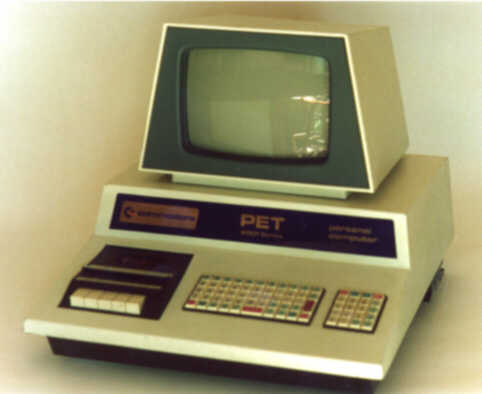
Micosoft income for 1976: $104,216 with pretax profit $22,496.
In November 1976 Allen quits MITS and Gates quits Harvard in February 1977 so that both work at Microsoft full time. On 3 February 1977 Gates & Allen make a new deal: Gates 64% Allen 36%.
During 1977 MITS, which was in the process of being taken over by Pertec, refused to license the 8080 BASIC to potential customers. On 20 April 1977 Gates & Allen sent a letter to MITS protesting their lack of making "best efforts" to commercialize the program. MITS responded by getting a judge to restrain Microsoft from disclosing 8080 BASIC code to any 3rd party and taking Microsoft to arbitration to force them to abide by the contract. Microsoft's income begins drying up that summer. They get bailed out in August by a $10,500 payment for the 6502 BASIC from Apple Computer for the Apple II.
Apple II Computer, 1977
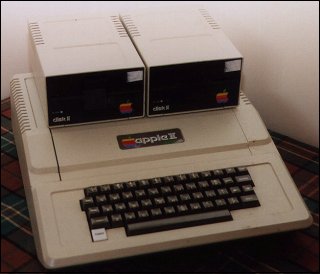
At the beginning of September 1977 the arbitrator ruled that MITS had violated the contract with Microsoft and terminated the exclusive license. Microsoft was now free to sell its BASIC to all comers.
The result was a flurry of deals to sell BASIC -- the most important was to Radio Shack. Gates left "hooks" in the BASIC code that went into ROM in the TRS-80. This allowed Microsoft to load extra functions from cassette or disk and gave it an advantage over other software writers. This became a standard practice at Microsoft for many years.
Radio Shack TRS80, 1977
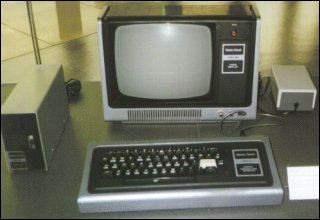
That fall, Gates and Marc McDonald come up with the File Allocation Table (FAT) during the development of a version of BASIC for NCR. This later was crucial to Standalone BASIC.
During November 1977 Gates considers moving Microsoft to California and merging with Digital Research. Gary Kildall had released CP/M (Control Program for Microcomputers) that summer. Microsoft had just developed its first version of FORTRAN but it required an operating system -- CP/M -- in order to run (BASIC could serve as its own crude operating system). So a merger seemed like a good idea to Gates but it never got past some initial feelers.
Gary Kildall, 1942-1994
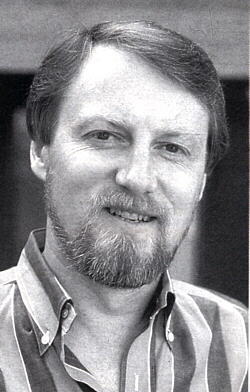
For 1977, Microsoft revenue was $381,715 with a net income of $112,471.
Management at Microsoft was at best chaotic. Neither Gates nor Allen had ever managed a business and Microsoft simply was not organized. Microsoft did not own a word processor and its records were kept in a ledger book. Callers were often directed to "the person who wrote the BASIC". Differences of opinion were settled by shouting matches. Gates would yell and scream about how stupid some idea or approach was and instruct everyone on how to do it better.
Gates' approach worked primarily because he was the hardest worker of them all. He had no social life and often slept on the floor in the office when he was into a project. Later he always had a housekeeper that took care of all mundane aspects of his life - buying groceries, paying bills, etc. He was famous for losing credit cards. His main vice was driving very fast cars in a very dangerous way and collecting multiple speeding tickets.
Late 1978 work begins on BASIC for the new Intel 8086 chip.
December 1978 Microsoft moves to Bellevue, Washington. Sales for calendar 1978, $1,355,665.
By March 1979 Microsoft had 48 OEM (Original Equipment Manufacturer) customers for 8080 BASIC, 29 for FORTRAN, and 12 for COBOL, and PASCAL and APL were under development.
Dan Bricklin and Bob Frankston develop VisiCalc, the first spreadsheet and demonstrate it in May 1979. Gates comes close to buying the company that had the rights to VisiCalc but the deal falls apart.
Bob Frankston and Dan Bricklin, 1979
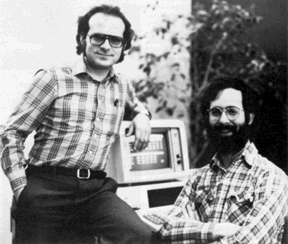
In June 1979 at the National Computer Conference in NY Microsoft's Standalone BASIC was shown running on Tim Paterson's {who later wrote DOS} 8086 Seattle Computer CPU. Tim Paterson also worked on Paul Allen's "SoftCard" idea for Microsoft. It ran CP/M on the Apple and was a highly successful product for a time. Indeed, the SoftCard was the single most popular platform to run CP/M!
Tim Paterson, author of QDOS

In August 1979 H. Ross Perot of EDS tries to buy Microsoft. Gates flies to Dallas and meets with EDS officials but is not impressed with their vision for microcomputers. Perot thought Gates wanted too much for the company and Gates was not really interested in selling. Perot regards his failure to meet Gates' price as his biggest business error.
In June 1980 Steve Ballmer comes to work at Microsoft for $50,000 per year and 5-10% of the Company depending upon revenue growth. His job as assistant to the President and he immediately begins to run the company in a much more business-like and orderly manner. Ballmer's downside was that, if anything, he was even more confrontational than Gates! And, he, unlike Gates, would get personal!
-
In late 1980 it was not clear to anyone which 16-bit chip would catch on in the market - Intel 8086, Zilog's Z-8000, Motorola 68000, National 16000. Gates decided to cover his bets with UNIX! His reasoning was that UNIX was a portable operating system and if it took off Microsoft could develop its languages for UNIX rather than for each separate chip. His idea was to modify UNIX to run on the various 16-bit chips then sell it along with his software.
Consequently, Gates licensed UNIX from AT&T for $2,000,000 and developed a 16-bit version of UNIX called XENIX.
Beginning in 1978 IBM had begun looking closely at the new microcomputer market and had teams investigating IBM's entry into the market. In 1980 they launched a secret project they unofficially dubbed the "Manhattan Project" to develop a personal computer.
On 21 July 1980 Jack Sams, head of the Software side of IBM's secret personal computer project, contacts Microsoft and on 22 July 1980 they meet with Gates and Ballmer in Redmond. Gates & Ballmer immediately agree to sign a non-disclosure agreement. Without tipping its hand, the IBM people were interested in seeing if Microsoft could deliver the software they needed and whether they were organized and professional enough to meet deadlines. The IBM people concluded that Microsoft could deliver.
Almost at the same time IBM decided on an "open architecture" approach. The IBM PC was to be designed around an open hardware bus not unlike the Altair's or the Apple II's and the specifications were to be published. IBM correctly concluded that this would encourage third parties to add value to the new systems. By publishing the software specifications, IBM would stimulate outside developers to come up with new and different applications.
On 21 August 1980 IBM agrees to buy Microsoft's product line of languages - BASIC, FORTRAN, COBOL, Pascal - for the IBM PC for $600,000. Microsoft had been working on 8086 16-bit versions of all of its software so they were almost ready to be delivered anyway (IBM had decided to use the 8088 chip - a cheap version of the 8086 with an 8-bit data path).
IBM needed a 16-bit operating system for its PC. Gates tells the IBM people that DR is almost ready with CP/M-86 and he calls Gary Kildall about IBM's interest. Gates sent the IBM people down to see Kildall but Kildall's wife who handled the business refused to sign the nondisclosure agreement and after many fruitless hours, the IBM people left (Kildall was not at the meeting, he had flown off to see a customer).
Despite the many legends about this episode, CP/M-86 was not yet ready to go. Kildall also knew that IBM would demand a license that entitled them to modify CP/M-86 and he was not certain that it was a good idea to license away his only product (his only other product was PL/1) for a flat fee.
As fate would have it, Tim Paterson of Seattle Computer developed Quick and Dirty Operating System (QDOS) in 1980 for the 8086 computer that he had assembled. In part he cloned CP/M and in part he cloned old DEC operating systems. He also used a File Allocation Table (FAT) to handle the disk.
In early August 1980 Rod Brock of Seattle Computer wrote Paul Allen offering a cross-licensing agreement - 86-DOS in exchange for the right to use Microsoft's languages that were being developed for the 8086 chip!
On 25 September 1980 Paul Allen wraps up a deal with Seattle Computer for their 86-DOS. Microsoft paid an up front fee of $10,000 to gain the right to distribute 86-DOS to an unlimited number of end users. For an additional fee of $10,000 per company, or $15,000 if source code was included, Microsoft could sublicense 86-DOS to OEM customers. The deal was nonexclusive so that Seattle Computer could also license 86-DOS.
On 6 November 1980 Microsoft signs the deal with IBM. IBM was prohibited from licensing Microsoft's software to 3rd parties but Microsoft itself was free to do so! Microsoft also got royalties for all its software.
1 July 1981 Microsoft Corporation is formed -- Gates 53%, Allen 31%, Ballmer 8%, Raburn 4%, Simonyi & Letwin 1.5% each.
In July 1981 Microsoft wakes up to the fact that they were sitting on a potential gold mine. Seattle Computer had already been approached by one company who wanted to license 86-DOS. Microsoft buys DOS outright on 27 July 1981 for $50,000 in "the deal of the Century". Seattle Computer got a royalty free license and could license DOS to buyers of its own computers only. Seattle Computer also got a price break on all Microsoft languages. At the time Brock thought it was a good deal since he did not want to be in the software business. Tim Paterson, who was working for Microsoft on MS-DOS, read the agreement and thought it was a fair deal.
Evolution of DOS/WINDOWS
August 1981 DOS 1.0
March 1983 DOS 2.0
August 1984 DOS 3.0
November 1985 WINDOWS 1.0
October 1986 DOS 4.0
October 1987 WINDOWS 2.0
December 1987 OS/2 1.0
October 1988 OS/2 1.1
May 1990 WINDOWS 3.0
June 1991 DOS 5.0
March 1992 OS/2 2.0
April 1992 WINDOWS 3.1
May 1993 OS/2 2.1
July 1993 NT 3.1
September 1994 NT 3.5
October 1994 OS/2 3.0
June 1995 NT 3.51
August 1995 WINDOWS 95
August 1996 OS/2 4.0
August 1996 NT 4.0
June 1998 WINDOWS 98
February 2000 WINDOWS 2000
12 August 1981 IBM announces the Personal Computer. Gates & Allen are not invited to the rollout.That same month Steve Jobs visits Microsoft for the first time and gives a mesmerizing speech about his vision for computing (the Reality Distortion Field). In October Gates travels to Cupertino to see an early mockup of the Macintosh Computer.
Steve Jobs
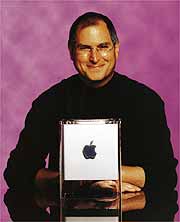
Jobs had initially opposed the Mac within Apple for two years on the assumption that the Apple Lisa (being developed by ex-PARC alumni) would be far superior. (Jobs had toured PARC in 1979 and immediately set out to build a GUI [graphics user interface] computer.) After being kicked out of the Lisa project Jobs switched allegiance to the Mac project being run by Jef Raskin (another PARC alumnus).
The Apple Lisa
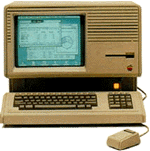
Gates makes a deal with Jobs & Apple to supply software for the Macintosh. Microsoft and Apple sign a contract on 22 January 1982 to provide a spreadsheet, a business graphics program, and a database. Microsoft was prohibited from distributing software that used a Mouse before 1 January 1984! Gates was later to take advantage of that deadline. He was convinced after viewing the Apple Mac that GUI was the future.
Jef Raskin -- Developer of the MAC
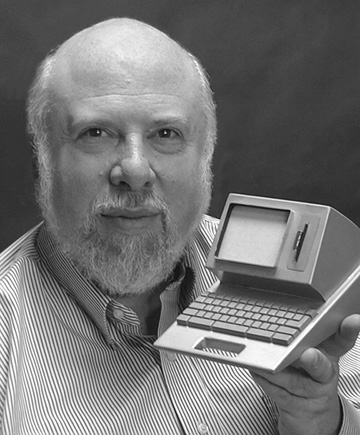
Gates and Jobs - for different reasons - were both keen to get a spreadsheet program to compete with VisiCalc. Gates realized that the market was shifting away from languages and toward applications, and Jobs wanted his own spreadsheet program so he did not have to pay royalties to VisiCalc. This first Microsoft spreadsheet was called Multiplan.
In 1981 Apple had total sales of $334M and profits of $39.4M, Microsoft, $15M gross and $1.5M net was a bit player. That same year Apple sold 150,000 computers and IBM sold 200,000 computers.
In late 1981 and early 1982 most analysts expected CP/M-86 for the IBM PC to kill DOS off the moment it became available. However, IBM charged $240 for CP/M-86 when it did come on the market in the spring of 1983 and by then it was too late. The experts misread the market. However, the situation was crystal clear independent software developers (a pattern that would repeat itself with WINDOWS 3.0). They were writing a flood of new DOS programs and virtually none for the CP/M-86.
In the beginning Gates almost gave MS-DOS away - often charging less than half the official price of $95,000 to OEM customers. This allowed Gates to get MS-DOS established before the ever-so-slow Gary Kildall could get CP/M-86 onto the market.
Gates clearly formulated his DOS strategy very early on. At a computer forum in May 1981 he said: "Why do we need standards? … It's only through volume that you can offer reasonable software at a low price. Standards increase the basic machine we can sell into…..I really shouldn't say this, but in some ways it leads, in an individual product category, to a natural monopoly: where somebody properly documents, properly trains, properly promotes a particular package and through momentum, user loyalty, reputation, sales force, and prices builds a very strong position within that product."
A second aspect of Gates' overall strategy revealed itself in early 1982 when Compaq built the first legal IBM-compatible computer by reverse engineering IBM's ROM BIOS (Read Only Memory Basic Input Output System). Microsoft gave both MS-DOS and PC-DOS code to Compaq to ensure it could develop a fully compatible computer.
BASIC was more problematic because it was both on disk and in ROM. Gates solved this problem by assigning a separate team of BASIC programmers to the Compaq project and as Compaq fed back changes they needed in BASIC, Gates simply incorporated them into the new editions of the ROM BASIC that Microsoft provided IBM! This kept everything legal.
In late 1982 Paul Allen contracts Hodgkins disease and resigns from Microsoft just before the release of DOS 2.0. March, 1983, DOS 2.0 released along with the IBM XT. Paul Allen had fought vigorously for drastically upgrading DOS and after a classic screaming match with Gates Allen prevailed. DOS 2.0 contained a laundry list of UNIX like features and was drastically re-written.
DOS 2.0
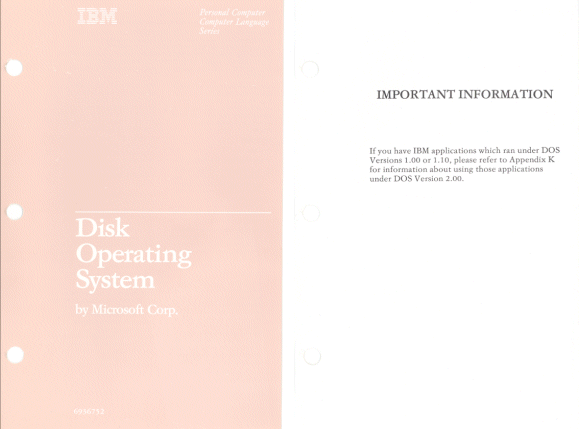
By 1982 Microsoft had 200 employees and sales of $32,000,000.
By the fall of 1982 Microsoft has as many programmers on the Mac project as Apple did. Gates and his programmers (the "Smart Guys") were convinced that the Mac was the computer of the future and the software development was proceeding at a breakneck pace. Simultaneously, Gates and Allen were pondering how to build a GUI for the IBM PC as early as February 1982.
At the fall 1982 Comdex Lotus 1-2-3 was released. Although 1-2-3 bypassed DOS and worked directly with the IBM PC hardware (in order to get enough memory), this only served to reinforce the IBM PC standard and started a flood of PC specific software.
Also at the fall 1982 Comdex VisiCorp (owners of VisiCalc the "Killer Ap" for the Apple II) displayed VisiOn a MAC/SINDOWS-like GUI.
Gates begins the development of WINDOWS (called Interface Manager) to head off VisiOn. Interface Manager was classic Gates: Vaporware - do a demo, sign the contracts, get the code done later. In April 1983 a phony "smoke-and-mirrors" demo was done. Microsoft promoted Interface Manage throughout 1983 with great zeal (allegedly tying its purchase to the purchase of DOS in clear violation of antitrust law). On 10 November 1983 Microsoft announced Windows with great fanfare in New York City to try to head off VisiOn. IBM refuses to endorse Windows and actively works against Microsoft's interests.
Gates was determined not to miss the applications boat again - he missed it with DOS he was not going to miss it with the coming change to a GUI. He was determined that Windows was going to be the new standard and that Microsoft would have the inside track on applications development.
To implement this strategy Microsoft developed its own Mouse and released it in June 1983. Microsoft engineers figured out how to power the mouse through the Serial Port and the concept was eventually patented.
At first there was no software at all that worked with the Mouse but by November 1983 Microsoft released WORD. WORD supported the Mouse and had plenty of features that took advantage of it.
This activity by Microsoft made Jobs and Apple nervous for obvious reasons. Gates argued that the contract Microsoft signed to work on the Mac project did not prevent Microsoft from working on an overall operating environment and the contract expired 1 January 1984 in any case. Gates and Jobs formally rescinded their old agreement for applications development on 15 January 1984 - just one week before the release of the Mac.
VisiOn comes out in September 1983 and turns out to be an expensive dud. Once again Microsoft benefited from inept competition.
Mitch Kapor of Lotus was not inept however. Lotus was riding high because of 1-2-3 and Lotus made more money than Microsoft in 1983.
Bill Gates, Mitch Kapor, Fred Gibbons, 1984
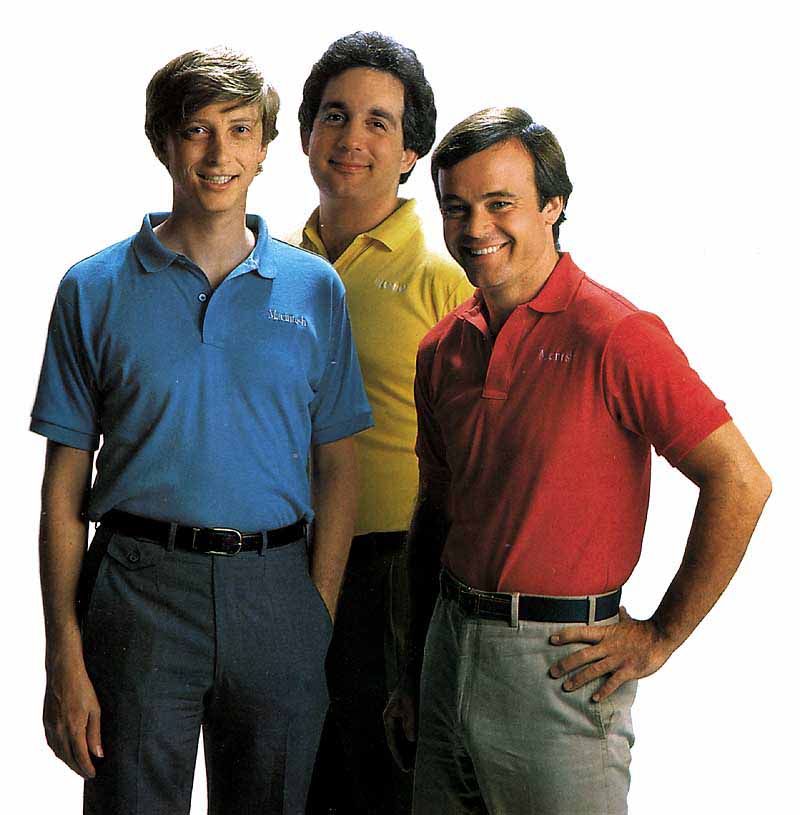
Gates was so worried about Lotus's Symphony -- an integrated "be-all, end-all" product - he re-directs the development of Excel from a DOS spreadsheet to the MAC to head off Lotus.
Late in 1983 Borland releases Turbo Pascal for only $49.95 and eats Microsoft's lunch. It featured an integrated editor-compiler and quickly became the standard severely cutting into Microsoft's language market.
Turbo Pascal

In 1983 Microsoft sales were $55,000,000.
By 1984 about 10,000,000 personal computers where shipping a year and most of them had DOS on them. By this time Microsoft had switched to per-machine deals with vendors. Microsoft would give computer makers a price break on DOS if they would also buy BASIC for a large number of machines (most makers way overestimated what their market share would be). Per-machine deals made it virtually impossible for competitors to crack the DOS monopoly. Vendors that were already paying a royalty for DOS on every machine were not going to offer a different operating system except as a high-priced option!
Microsoft in effect collected a bounty, a tax virtually every time anybody bought a DOS machine from someone other than IBM! It was a vast money machine that expanded even further in May 1984 when Phoenix Software Associates was able to reverse-engineer the IBM PC ROM BIOS and would sell its ROM BIOS chip to all comers. The market exploded as a result.
In August 1984 AT with 80286 and DOS 3.0 was released. The keyboard of the AT has a new key - SysRq (system request). This was an attempt by IBM to distance itself from Microsoft by enabling it to run other operating systems by simply hitting the SysRq key. Part of this effort was TopView, which was supposed to allow multi-tasking, and was clearly intended to block Windows and other similar products.
Fiscal 1984 Microsoft sales were $100,000,000.
-
January 1985, Windows is now about 2 years late. Neil Konzen, Microsoft's
Mac wizard, is brought in to get it moving. Further delaying the product is Gates' insistence
that Windows also have a keyboard interface (keyboard equivalents to the Mouse). Microsoft
ships a beta version in July, 1985, and on 20 November 1985 Windows 1.0 finally shipped.
WINDOWS 1.0

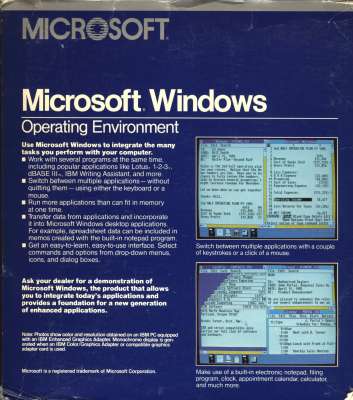
(photo courtesy of EMS Company)
June 1985 Joint Development agreement signed with IBM. This new agreement superceded the old 1980 agreement and got IBM out of its liability if the DOS source code was disclosed to customers. Gates is unable to get the IBM people to look seriously at Windows.
In early 1985 Apple is doing poorly. Mac sales were 20,000 per month which was far below the forecast of 80,000 per month. Gates writes a letter on 25 June 1985 urging Apple to license its Mac technology so the clone makers could get into making Macs. Gates offered to help convince Compaq, Sony, TI, etc., to make Macs and thereby cause the Mac market to become huge. Apple did not license its technology but did sign an ambiguous agreement with Microsoft that November allowing Microsoft to go ahead with Windows.
Microsoft stock finally goes public on 13 March 1986 with the initial public offering. Gates worth $311,000,000 the first day it was issued.
In December 1986 Gates buys out Seattle Computer's DOS license for $925,000 after Seattle Computer takes Gates to court for trying to deny them the right to sell their DOS license! Gates also buys out Tim Paterson's DOS license for $1,000,000, buys into his business, and gives him a generous job contract (he later makes $20,000,000 when he sells out his share of his business).
Meanwhile Microsoft and lumbering IBM move ahead with what becomes OS/2. At first IBM's aim is to cut Microsoft out by developing a common interface for all of its computers from mainframes to PCs (SAA = Systems Applications Architecture). Gates and Ballmer then scramble to convince IBM to also use Windows as an interface.
This "compromise" eventually evolved into Presentation Manager but the result was that Microsoft managed to live to fight again another day.
The 1986-1988 period saw Microsoft constantly scrambling to protect its interests vis a vis IBM during their "joint" effort to develop OS/2 (it started out as CP-DOS). Ballmer and Gates would do anything to keep the relationship alive (BOGU) for fear of being crushed by IBM.
Microsoft's code writers were contemptuous of IBM and it's coding culture. In the increasingly irrelevant world of IBM, the classical languages were COBOL, PL/1, and BAL (Basic Assembly Language), NOT C!
In addition, IBM wrote "clunky" code that was top-heavy with lines of documentation to make the software "easy to service."
Finally, in December 1987 OS/2 1.0 without Presentation Manager was released. Not until October 1988 is OS/2 1.1 with PM released with a resounding thud. In 1988 only about 4% of 286 and 16% of 386 users purchased OS/2 while Gates was selling Windows at the rate of 50,000 copies per month.
In March 1987 Bill Gates becomes a Billionaire at age 31 and by the 3rd Quarter of 1987, Microsoft passes Lotus to become the largest PC software vendor (1987 revenue, $345,900,000).
In October 1987 Windows 2.0 is released and Compaq and Microsoft developed Windows 386 to run on Compaq's line of 80386 machines.
WINDOWS 2.0
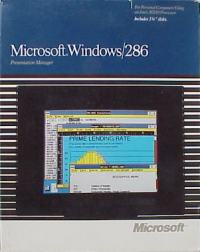
Borland, Ashton-Tate, and Lotus refuse to develop for Windows fearing that, in the words of Philippe Kahn: "People are afraid Microsoft is going to take control of the operating system."
Philippe Kahn and Steve Ballmer


By this time Microsoft's competitors are complaining loudly (and correctly) about Microsoft's undocumented calls in DOS & Windows that gave its applications division an advantage over its competitors.
Microsoft's legal difficulties multiplied greatly when Apple filed its "Look and Feel" lawsuit in March 1988. One year later Apple wins a preliminary skirmish when a judge rules that Microsoft could only use the visual displays in the very first version of Windows - not those in Windows 2.
When Microsoft's stock nose-dived, Steve Ballmer bet $46,200,000 on the company by purchasing 945,000 shares of Microsoft stock. This purchase would later make Ballmer a Billionaire.
On 31 October 1988 Bill Gates in one of his best decisions hired David Cutler and his development team away from DEC. Cutler had developed VMS and he and his group were "smart guys" - just the sort of people Gates loved to hire.
Gates had a vision from early on to develop, from scratch, a completely new operating system that would run on all the major Microprocessors and would, in effect, bring the powerful features of high-end Unix to the PC masses. With Cutler he had the leader and core group of programmers to make that vision a reality.
By late 1989 the development of what was to become OS/2 2.0 (32-bit flat) was bogged down in the usual IBM "bureaucratic sclerosis". Many of the major software houses were developing for OS/2 and had placed heavy bets that it would be the operating system for the "high-end" PC.
IBM OS/2
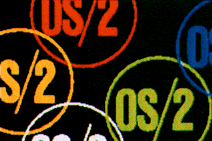
Microsoft was still promoting Windows and was focusing most of its Applications software development on Windows. Consequently, Microsoft's Applications competitors were getting very nervous about OS/2 because if Windows became the standard then Microsoft would eventually dominate the Applications market as well as the operating systems market.
IBM felt that OS/2 should be the "high-end" operating system while Windows would be the "low-end" operating system. At the November 1989 Comdex in Las Vegas the open break between IBM and Microsoft occurred. Neither company was prepared to unambiguously endorse the other's operating system.
In May 1990 Windows 3.0 is released and is an instant mega-hit. In the first year 4,000,000 copies of Windows 3.0 were sold - more than all the Mac machines produced since 1984.
WINDOWS 3.0
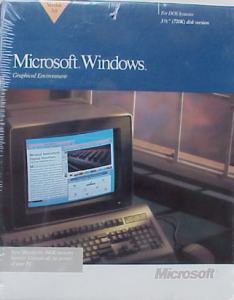
Microsoft's dominance of the operating systems market is now assured pending the resolution of the Apple "look-and-feel" suit (essentially decided in Microsoft's favor in April, 1992 although aspects dragged on until 1997).
That fall IBM and Microsoft part company permanently. IBM retains control of the development of OS/2 1.X and 2.0 while Microsoft is responsible for OS/2 3.0. OS/2 3.0 is, in effect, the NT project.
In January 1991 Microsoft unveils WIN32 (essentially a library of C subroutine calls) which will be the foundation of all of its future operating systems. The features that Microsoft built into WIN32 were essentially those that IBM had "reserved" for the "high-end" operating system.
WIN32

By mid-1992 Microsoft's capitalization was greater than Boeing and General Motors. At age 36 Bill Gates is the richest man in the United States. Microsoft is now unstoppable.
July 1993, Windows NT 3.1 is released and gets highly favorable reviews. The future of operating systems according to Bill Gates is now clear. Windows/DOS and Windows NT are to be eventually merged into one product running on all personal computers.
